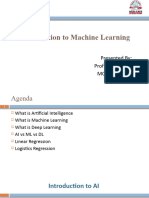0% found this document useful (0 votes)
20 views26 pagesMLT Unit 2 Linear Regression
Linear regression is a statistical method for predictive analysis that models the linear relationship between a dependent variable and one or more independent variables. It finds how the value of the dependent variable changes corresponding to the independent variable(s) and is used to predict continuous numeric variables like sales, salary, age and price.
Uploaded by
iafdeepakupretiCopyright
© © All Rights Reserved
We take content rights seriously. If you suspect this is your content, claim it here.
Available Formats
Download as PDF, TXT or read online on Scribd
0% found this document useful (0 votes)
20 views26 pagesMLT Unit 2 Linear Regression
Linear regression is a statistical method for predictive analysis that models the linear relationship between a dependent variable and one or more independent variables. It finds how the value of the dependent variable changes corresponding to the independent variable(s) and is used to predict continuous numeric variables like sales, salary, age and price.
Uploaded by
iafdeepakupretiCopyright
© © All Rights Reserved
We take content rights seriously. If you suspect this is your content, claim it here.
Available Formats
Download as PDF, TXT or read online on Scribd
/ 26




























































































